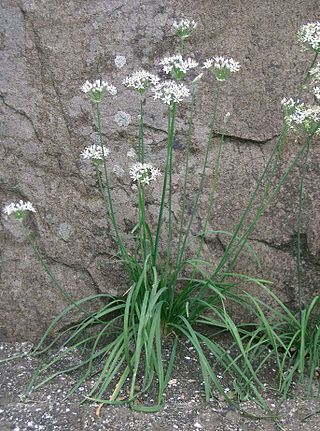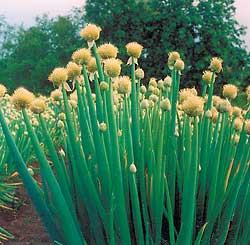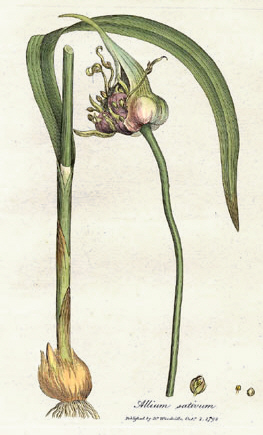
Scallions are vegetables derived from various species in the genus Allium. Scallions generally have a milder taste than most onions and their close relatives include garlic, shallot, leek, chive, and Chinese onions.

Allium tuberosum is a species of plant native to the Chinese province of Shanxi, and cultivated and naturalized elsewhere in Asia and around the world.

Allium fistulosum, the Welsh onion, also commonly called bunching onion, long green onion, Japanese bunching onion, and spring onion, is a species of perennial plant, often considered to be a kind of scallion.

The tree onion is a perennial plant similar to the common onion (A. cepa), but with a cluster of bulblets where a normal onion would have flowers. Tree onions are also known as topsetting onions, walking onions, or Egyptian onions. Genomic evidence has conclusively shown that they are a diploid hybrid of the shallot and the Welsh onion (A. fistulosum). However, some sources may still treat the tree onion as A. cepa var. proliferum or A. cepa Proliferum Group.

Allium canadense, the Canada onion, Canadian garlic, wild garlic, meadow garlic and wild onion is a perennial plant native to eastern North America from Texas to Florida to New Brunswick to Montana. The species is also cultivated in other regions as an ornamental and as a garden culinary herb. The plant is also reportedly naturalized in Cuba.

Allium neapolitanum is a bulbous herbaceous perennial plant in the onion subfamily within the Amaryllis family. Common names include Neapolitan garlic, Naples garlic, daffodil garlic, false garlic, flowering onion, Naples onion, Guernsey star-of-Bethlehem, star, white garlic, and wood garlic.

Allium nigrum, common name black garlic, broad-leaved leek, or broadleaf garlic, is a Middle Eastern species of wild onion. It lacks the onion or garlic scent shared by most of the other species in the group. The species is native to Turkey, Cyprus, Syria, Lebanon, and Israel but cultivated as an ornamental in many other places. It has become naturalized in some regions, including parts of the United States.

Allium moly, also known as yellow garlic, golden garlic and lily leek, Is a species of flowering plant in the genus Allium, which also includes the flowering and culinary onions and garlic. A bulbous herbaceous perennial from the Mediterranean, it is edible and also used as a medicinal and ornamental plant.

Allium textile is a common species of wild onion found in the central part of North America.

Allium roseum, commonly called rosy garlic, is an edible, Old World species of wild garlic. It is native to the Mediterranean region and nearby areas, with a natural range extending from Portugal and Morocco to Turkey and the Palestine region. It is cultivated widely, and has become naturalised in scattered locations in other regions outside its natural range.

Allium siculum, known as honey garlic, Sicilian honey lily, Sicilian honey garlic, or Mediterranean bells, is a European and Turkish species of plants genus Allium. It is native to the regions around the Mediterranean and Black Seas, and grown in other regions as an ornamental and as a culinary herb.

Allium victorialis, commonly known as victory onion, Alpine leek, and Alpine broad-leaf allium is a broad-leaved Eurasian species of wild onion. It is a perennial of the Amaryllis family that occurs widely in mountainous regions of Europe and parts of Asia.
Allium platyspathum is an Asian species of wild onion. It has been reported from Xinjiang, Afghanistan, Kazakhstan, Kyrgyzstan, Mongolia, Altay Krai, Tajikistan, Uzbekistan, and Pakistan. It grows in damp locations at elevations of 1900–3700 m.
Allium spirale, also known as Korean aging chive, is a plant species native to Korea, Primorye, and parts of China. It is cultivated in many other regions and has for some reason obtained the common name German garlic. Other common names include spiral onion, corkscrew onion, and curly chives.
Allium spurium is an East Asian species of wild onion native to Russia, Mongolia and China.

Allium flavum, the small yellow onion or yellow-flowered garlic, is a species of flowering plant in the genus Allium. A bulbous herbaceous perennial, it is native to the lands surrounding the Mediterranean, Black, and Caspian Seas, from France + Morocco to Iran + Kazakhstan.

Allium pallens is a species of wild onion native to the Mediterranean region and Middle East from Portugal and Algeria to Iran.

Allium is a genus of monocotyledonous flowering plants with hundreds of species, including the cultivated onion, garlic, scallion, shallot, leek, and chives. The generic name Allium is the Latin word for garlic, and the type species for the genus is Allium sativum which means "cultivated garlic".
The precise taxonomy of the genus Allium is still poorly understood with incorrect descriptions being widespread. With over 850 species distributed over the Northern hemisphere Allium is the sole genus in the Allieae, one of four tribes of subfamily Allioideae (Amaryllidaceae). New species continue to be described and Allium is both highly variable and one of the largest monocotyledonous genera, but the precise taxonomy of Allium is poorly understood, with incorrect descriptions being widespread. The difficulties arise from the fact that the genus displays considerable polymorphism and has adapted to a wide variety of habitats. Furthermore, traditional classications had been based on homoplasious characteristics. However, the genus has been shown to be monophyletic, containing three major clades, although some proposed subgenera are not. Some progress is being made using molecular phylogenetic methods, and the internal transcribed spacer (ITS) region, including the 5.8S rDNA and the two spacers ITS1 and ITS2, is one of the more commonly used markers in the study of the differentiation of the Allium species.














